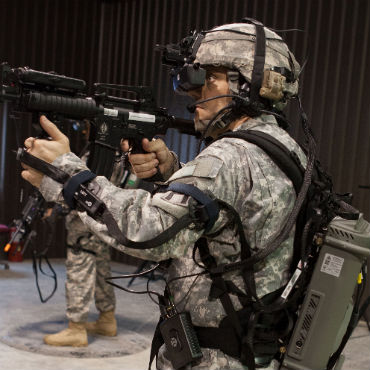Army looks to virtual training, shared intell amid budget cuts

The Army is planning to combine multiple training programs into a single environment to cut overhead costs.

Helmet-mounted displays are among the many virtual training tools the Army uses to prepare its troops. (U.S. Army photo by Maj. Penny Zamora)
Amid stagnant budgets and declining force size, Army leaders routinely stress the need to maintain readiness. Finite funding has placed a greater emphasis on simulation, virtual environments and shared platforms for intelligence, surveillance and reconnaissance in helping prepare soldiers for the next war.
The Army is planning to collapse at least three virtual programs into a single environment that encompasses integrated, across-the-board training, according to Army officials speaking last week at the AUSA Aviation symposium in Arlington, Va.
"For us to be able to execute realistic training, good training, we have to be able to bring that operational environment" into the virtual world and live gaming, said Brig. Gen. Michael Lundy, deputy commanding general at the Army Combined Arms Center. "As we look to the future, we are going to transition ... into the future holistic training environment, live synthetic. We want to get away from having multiple environments, virtual gaming and instruction, and go to one synthetic environment, get to a lower overhead and integrate the full operations process... according to the common operating picture."
Lundy said the Army will be trying out virtual training tools for the Defense Department's classified network at an upcoming Army Network Integration Evaluation – an effort that will move the Army forward in streamlined training at a time when training budgets are being squeezed.
"We have to reduce the overhead of training – right now for some simulations we've got 14 or 15 contractors or personnel that we need to be able to build the exercises, to run the simulations," Lundy said. "We can't afford that. That's a couple million dollars per installation we're paying in manpower."
The downward pressure on budgets also is stressing the Army's intelligence, surveillance and reconnaissance (ISR) capabilities. The service's aviation branch is set to undergo a restructuring for a smaller fleet that "basically allows us to take advantage of those best platforms and sensors that have been bought at great expense," said Lt. Gen. Mary Legere, Army deputy chief of staff for intelligence.
She and other top Army leaders emphasized interoperability between the components and services, as well as coordination of manned and unmanned ISR platforms, including drones. Legere said the Army will soon consolidate its aerial ISR fleet into a central location that will provide "a distributed approach" for signals intelligence.
"That's going to allow us to save money on brick and mortar and invest more in the sensors and the platforms that we want to retain," she said.
And, ideally, it will make training on ISR platforms easier – something that Legere said is critical to future operations.
"We have to be training to do a whole lot more ISR," she said. "You saw 'Zero Dark Thirty,' right? Ninety-nine percent of the movie you're looking for the guy and the last part of the movie we actually drop the bomb. So we've got to think about that as we look at how we train."
NEXT STORY: GSA's Koses moves up


